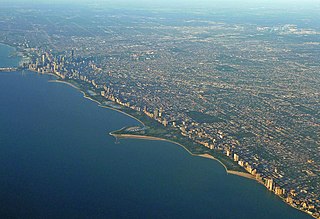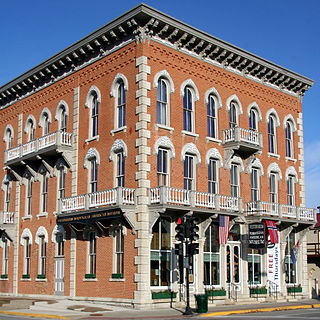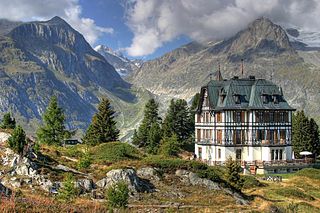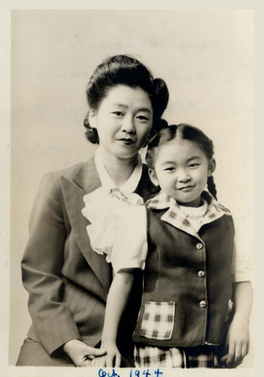The Arizona-Sonora Desert Museum is a 98-acre zoo, aquarium, botanical garden, natural history museum, publisher, and art gallery founded in 1952. Located just west of Tucson, Arizona, it features two miles (3.2 km) of walking paths traversing 21 acres of desert landscape. It is one of the most visited attractions in Southern Arizona.

The Field Museum of Natural History (FMNH), also known as The Field Museum, is a natural history museum in Chicago, Illinois, and is one of the largest such museums in the world. The museum is popular for the size and quality of its educational and scientific programs, and its extensive scientific specimen and artifact collections. The permanent exhibitions, which attract up to 2 million visitors annually, include fossils, current cultures from around the world, and interactive programming demonstrating today's urgent conservation needs. The museum is named in honor of its first major benefactor, Marshall Field, the department-store magnate. The museum and its collections originated from the 1893 World's Columbian Exposition and the artifacts displayed at the fair.

Lincoln Park is a 1,208-acre (489-hectare) park along Lake Michigan on the North Side of Chicago, Illinois. Named after US President Abraham Lincoln, it is the city's largest public park and stretches for seven miles (11 km) from Grand Avenue, on the south, to near Ardmore Avenue on the north, just north of the DuSable Lake Shore Drive terminus at Hollywood Avenue. Two museums and a zoo are located in the oldest part of the park between North Avenue and Diversey Parkway in the eponymous neighborhood. Further to the north, the park is characterized by parkland, beaches, recreational areas, nature reserves, and harbors. To the south, there is a more narrow strip of beaches east of Lake Shore Drive, almost to downtown. With 20 million visitors per year, Lincoln Park is the second-most-visited city park in the United States, behind Manhattan's Central Park.

The Museum of Science (MoS) is a nature and science museum and indoor zoological establishment located in Science Park, a plot of land in Boston and Cambridge, Massachusetts, spanning the Charles River. Along with over 700 interactive exhibits, the museum features a number of live and interactive presentations throughout the building each day, along with scheduled film showings at the Charles Hayden Planetarium and the Mugar Omni Theater. Additionally, the Museum of Science is an accredited member of the Association of Zoos and Aquariums (AZA), being home to over 100 animals, many of which the museum gained after they were surrendered, confiscated, rescued or rehabilitated.

The Science Museum of Minnesota is a museum in Saint Paul, Minnesota, focused on topics in technology, natural history, physical science, and mathematics education. Founded in 1907, the 501(c)(3) nonprofit institution has 385 employees and is supported by volunteers.

Oglebay Park is a self-supporting public municipal park, the only one of its kind, located on the outskirts of Wheeling, West Virginia, on 1,650 acres (670 ha). In 1926, Earl W. Oglebay deeded his estate, Waddington Farms, to the city of Wheeling for the express purpose of public recreation. The park has been open to the public since 1928 when its governing body, the Wheeling Park Commission, began operations.

Vesterheim Norwegian-American Museum in Decorah, Iowa is the National Norwegian-American Museum and Folk Art School, with over 33,000 artifacts, 12 historic buildings, and a library and archives. This treasure showcases one of the most extensive collection of Norwegian-American artifacts in the world and highlights the best in historic and contemporary Norwegian folk and fine arts. Some of its buildings are on the National Register of Historic Places.

The Children's Museum of Indianapolis is the world's largest children's museum. It is located at 3000 North Meridian Street, Indianapolis, Indiana in the United Northwest Area neighborhood of the city. The museum is accredited by the American Alliance of Museums. It is 472,900 square feet (43,933.85 m2) with five floors of exhibit halls and receives more than one million visitors annually. Its collection of over 130,000 artifacts and exhibit items is divided into two domains: Arts & Humanities and the Natural Sciences. Among the exhibits are simulated Cretaceous and Jurassic dinosaur habitats, a carousel, a steam locomotive, and the glass sculpture Fireworks of Glass Tower and Ceiling. The museum's focus is family learning; most exhibits are designed to be interactive, allowing children and families to actively participate.
The Museum of Life and Science—previously known as the North Carolina Museum of Life and Science and the NC Children's Museum—is an 84-acre (340,000 m2) science museum located in Durham, North Carolina, United States.

The Museum of Appalachia, located in Norris, Tennessee, 20 miles (32 km) north of Knoxville, is a living history museum that interprets the pioneer and early 20th-century period of the Southern Appalachian region of the United States. Recently named an Affiliate of the Smithsonian Institution, the museum is a collection of more than 30 historic buildings rescued from neglect and decay and gathered onto 63 acres (25 ha) of picturesque pastures and fields. The museum also preserves and displays thousands of authentic relics, maintains one of the nation's largest folk art collections, and hosts performances of traditional Appalachian music and annual demonstrations by hundreds of regional craftsmen.

The Western Development Museum is a network of four museums in Saskatchewan, Canada preserving and recording the social and economic development of the province. The museum has branches in Moose Jaw, North Battleford, Saskatoon and Yorkton. Respectively, each branch focuses on a different theme: transportation, agriculture, economy, and people. The museum is affiliated with the Canadian Museums Association, the Canadian Heritage Information Network, and Virtual Museum of Canada.
The Forest Preserve District of DuPage County is a governmental agency headquartered in Wheaton, Illinois, United States. Its mission is to acquire and hold lands containing forests, prairies, wetlands, and associated plant communities or lands capable of being restored to such natural conditions for the purpose of protecting and preserving the flora, fauna and scenic beauty for the education, pleasure and recreation of the citizens of DuPage County.

The Pacific Grove Museum of Natural History is a museum of natural history located near the Monterey Bay Aquarium in Pacific Grove, California, United States. The museum is a living field guide of the California Central Coast showcasing local native plants, animals, geology, and cultural histories.

A nature center is an organization with a visitor center or interpretive center designed to educate people about nature and the environment. Usually located within a protected open space, nature centers often have trails through their property. Some are located within a state or city park, and some have special gardens or an arboretum. Their properties can be characterized as nature preserves and wildlife sanctuaries. Nature centers generally display small live animals, such as reptiles, rodents, insects, or fish. There are often museum exhibits and displays about natural history, or preserved mounted animals or nature dioramas. Nature centers are staffed by paid or volunteer naturalists and most offer educational programs to the general public, as well as summer camp, after-school and school group programs. These educational programs teach people about nature conservation as well as the scientific method, biology, and ecology.

The George Washington Carver Museum is a museum located in Tuskegee, Alabama, United States. It is a part of the Tuskegee Institute National Historic Site. The museum, located on the campus of Tuskegee University, is managed by the US National Park Service, with self-guided tours.
The Autrey Mill Nature Preserve & Heritage Center is located in Johns Creek, Georgia, United States.
The Raupp Memorial Museum is an organization that chronicles the social history of Buffalo Grove, Illinois. It is part of the Buffalo Grove Park District and an award-winning member of the Illinois Association of Museums.

Malvern and Brueton Park is a town park and local nature reserve in Solihull in the West Midlands, England. The park is formed from a comparatively narrow strip of land, with the length being approximately ten times the average width, but it is looped forming a roughly U-shaped layout. The parks cover an area of approximately 130 acres (53 ha). Historically the park was formed by the joining of two separate parcels of different land. There is a large water feature, Brueton Park Lake, which runs through the southern end of the park, and is formed by the damming of a local watercourse, the River Blythe.

Mary Tsuruko Dakusaku Tsukamoto was a Japanese American educator, cultural historian, and civil rights activist. She had taught in the Elk Grove Unified School District in Sacramento, California, for 26 years, and was described as having a passion to teach children how to learn from experience. The daughter of Japanese parents, she was relocated to an internment camp at Jerome, Arkansas, after the United States entered World War II. She developed a program about the internment period that is part of the California state curriculum for fifth grade history and a California Museum of History tour exhibit. She worked for Japanese American civil liberties, and played a pivotal role in the grassroots effort that led to the Civil Liberties Act of 1988. She also worked with the Smithsonian Institution in Washington DC, where she developed an exhibit on internment for the Constitution's bicentennial. In March 2006, she was posthumously recognized as a National Women's History Month honoree.

The Stamford Museum & Nature Center, located in Stamford, Connecticut, is an art, history, nature, and agricultural sciences museum. The property covers 118 acres beginning about half a mile north of the Merritt Parkway. It was originally a private estate.

















